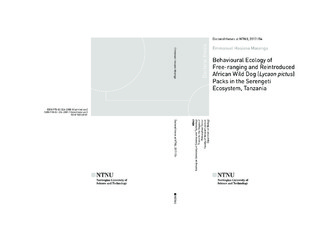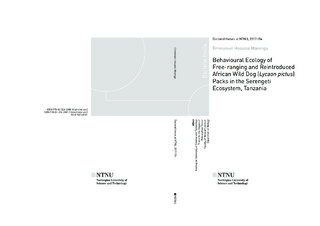| dc.contributor.advisor | Røskaft, Eivin | |
| dc.contributor.advisor | Jackson, Craig | |
| dc.contributor.author | Masenga, Emmanuel Hosiana | |
| dc.date.accessioned | 2017-06-13T12:28:56Z | |
| dc.date.available | 2017-06-13T12:28:56Z | |
| dc.date.issued | 2017 | |
| dc.identifier.isbn | 978-82-326-2381-5 | |
| dc.identifier.issn | 1503-8181 | |
| dc.identifier.uri | http://hdl.handle.net/11250/2445942 | |
| dc.description.abstract | Worldwide, large carnivore conservation has become an increasing challenge in the face of human population growth and anthropogenic development adjacent to protected areas. African wild dogs (Lycaon pictus) range widely and have low population densities. Such behaviours may expose the species to more anthropogenic influences than other large carnivores.
The Loliondo Game Controlled Area (LGCA) is characterized by a recently increasing human population with the majority being semi-nomadic Maasai pastoralists. The area has simultaneously accommodated an average of 10 packs of wild dogs, totalling about 120 individuals per year for the past decade. The packs range in different areas, avoiding areas near village centres, and the highest mean numbers of sightings were located in treed shrubland vegetation. Furthermore, retaliatory killings of wild dogs through poisoning of adult wild dogs and burning of pups in dens by local people due to livestock depredation, represents the greatest threats to wild dog conservation in the area.
An analysis of dispersal movement behaviour revealed the longest distances moved by wild dogs recorded to date. The two disperser groups covered straight-line distances of 250.4 and 520 km. We further observed that the dispersers utilized natural vegetation, as opposed to transformed habitats, more than 90% of the time.
In terms of home range utilization and habitat selection by African wild dogs, analysis of GPS satellite collar data revealed that the free-ranging packs had shorter step lengths, higher clustering in June - September and no clear patterns in the net squared displacement (NSD) compared to the reintroduced packs, which had smaller and larger core home range sizes throughout the long and short dry seasons, respectively. The wild dogs also changed foraging behaviours between seasons under different woody covers and selected different landforms during day and night. Hilly areas were preferentially selected during the night, and breaks, hills and low mountains were preferentially selected during daylight hours.
Our results further revealed that ten potential prey species of small to medium size herbivores were found within wild dog home ranges, of which Thomson's gazelle (Eudorcas thomsonii), wildebeest (Connochaetes taurinus), impala (Aepyceros melampus) and zebra (Equus quagga) showed the highest mean densities. Furthermore, a faecal analysis showed that Kirk's dik dik (Madoqua kirkii), Grant's gazelle (Nanger granti), impala and Thomson's gazelle had significant spatio-temporal variability. Grant's gazelle and impala were the most preferred species by wild dog packs in the Serengeti ecosystem.
Evaluation of the wild dog reintroduction programme showed mixed levels of success after four packs established home ranges in livestock-free areas in the western part of the Serengeti ecosystem. The NSD model indicated that one reintroduced pack showed high release site fidelity. Survival rates for both the reintroduced and free-ranging male wild dogs to the age of 12 months were relatively high, with 68.29 % (n = 28) and 65.38 % (n = 17) respectively. We found no significant difference in survival rate between free-ranging and released individuals, but females tended to have lower survival than males, and pups had significantly lower survival than adults. Furthermore, two reintroduced packs reproduced successfully with an average of six pups survived after denning.
Based on our findings, effective monitoring of wild dogs in the Serengeti ecosystem should adopt a multi-institutional approach in a joint effort to conserve wild dogs to attain a long-term viable population. A detailed analysis of the movement behaviour of both resident and dispersing wild dog packs between natural vegetation cover and developed human areas is essential for future assessment of available habitat patches and population connectivity for wild dog conservation.
The findings from prey occurrences in the wild dog home ranges suggested that future research should focus on the influence of the landscape features (i.e., topography) on African wild dog prey selection in the Serengeti ecosystem. Lastly, we determined in this study that reintroduction had mixed success based on pack establishment under the two wild dog pack release protocols. Therefore, it is essential to further evaluate the reintroduction programme using longer-term data by incorporating other factors, including the eventual site of establishment, habitat suitability, assessment of community changes in attitudes on livestock depredation incidences by wild dogs in LGCA and wild dog packs utilization during denning into different landscape in the Serengeti ecosystem. | nb_NO |
| dc.language.iso | eng | nb_NO |
| dc.publisher | NTNU | nb_NO |
| dc.relation.ispartofseries | Doctoral theses at NTNU;2017:154 | |
| dc.relation.haspart | Paper 1: Emmanuel Masenga, Craig Jackson, Ernest Mjingo, Roel May, Robert Fyumagwa, Richard Lyamuya and Eivin Røskaft. Status of the African wild dog population in Loliondo Game Controlled Area, Tanzania. | nb_NO |
| dc.relation.haspart | Paper 2: Masenga, Emmanuel Hosiana; Jackson, Craig Ryan; Mjingo, E E; Jacobson, Andrew; Riggio, Jason; Lyamuya, Richard Daniel; Fyumagwa, R.D.; Borner, Markus; Røskaft, Eivin. Insights into long-distance dispersal by African wild dogs in East Africa. African Journal of Ecology 2016 ;Volum 54. s. 95-98 | nb_NO |
| dc.relation.haspart | Paper 3: Emmanuel Masenga, Craig Jackson, Roel May, Ernest Mjingo, Robert Fyumagwa, Mtango Mtahiko, Inyasi Lejora, Richard Lyamuya and Eivin Røskaft (Submitted). Home range utilization and habitat selection by African wild dogs (Lycaon pictus) in the Serengeti ecosystem, Tanzania | nb_NO |
| dc.relation.haspart | Paper 4: Emmanuel Masenga, Craig Jackson, Roel May, Ernest Mjingo, Robert Fyumagwa, William Mwakilema, Richard Lyamuya and Eivin Røskaft (Submitted). Influence of prey abundance on diet choice by wild dog packs in the Serengeti ecosystem, Tanzania. | nb_NO |
| dc.relation.haspart | Paper 5: Emmanuel Masenga, Ernest Mjingo, Robert Fyumagwa, Julius Keyyu, Craig Jackson, Roel May, Frode Fossøy, Emilian Kihwele, Morris Kilewo, Idrissa Chuma, Kuya Sayalel, Emmanuel Macha, Alex Choya, Elibariki Bajuta, Richard Lyamuya and Eivin Røskaft (Manuscript). Evaluation of the wild dog reintroduction programme into Serengeti National Park, Tanzania. | nb_NO |
| dc.title | Behavioural Ecology of Free-ranging and Reintroduced African Wild Dog (Lycaon pictus) Packs in the Serengeti Ecosystem, Tanzania | nb_NO |
| dc.type | Doctoral thesis | nb_NO |
| dc.subject.nsi | VDP::Mathematics and natural science: 400::Basic biosciences: 470 | nb_NO |

